Know Your Tree
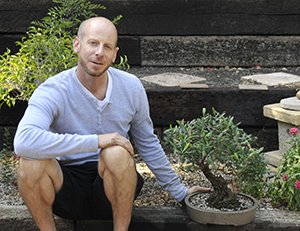
Olea Europaea ‘Little Ollie’
by Lew Buller
Eitan the Apprentice with olive he just transplanted June 8, 2014.
When I first started learning about bonsai, I used to wander around the many San Diego nurseries expecting to find a hidden gem and take it home at a bargain price. It didn’t happen. Instead, I began to look through the sale items that had crooked trunks, roots exposed from years of heavy watering, one-sided trees–misfits, in other words. I acquired a taste for such trees and that accounts for some of the designs I have to this day. They were cheap; I didn’t intend to kill them, but if I did, I had not lost a fortune.
Before I started writing this, I checked the Internet to see if someone else had written about a ‘Little Ollie” bonsai. Didn’t find any articles, but did find a lot of advertisements from garden centers supplying this olive. None of them advertised plants in early stages of development.
Ollie is an olive shrub that can be used as a hedge. It bears almost no fruit and therefore does not make the mess that the fruit-bearing olives do. Northern California was the place to grow olives for a long time because they required a cold snap to set fruit. More recent varieties will set fruit in Southern California. I have another olive bonsai which does set fruit. The fruit is called a drupe and is very messy when it falls on sidewalks. Spraying in early spring with a chemical that prevents fruit from setting is used by owners of ornamental olives. I worked as a part-time arborist for 15 years and recall being on the roof of restaurant in Mission Bay cutting back fruit-bearing branches that were dropping drupes on the courtyard patio because the owner had forgotten to spray.
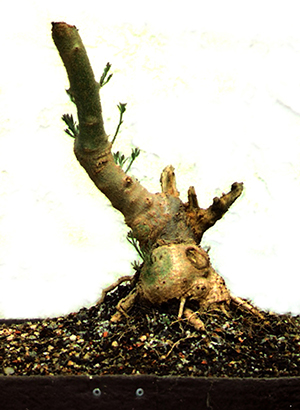
The Ollie I have cost $10 in a local nursery; I took it home to experiment with it. Olives can withstand severe pruning and will sprout new buds even if all branches are cut off. One has to work hard to kill an olive. Beginners can learn many techniques safely on olives.
The bulbous base caused a design problem, so I decided to cut the front of it off and hollow out the trunk. Many old olives growing on their own will have dead sections, which makes olives pretty much useless as a source of lumber. Because of the denseness of the wood and the spalting that usually occurs, olive wood can be made into small decorative pieces. That same hardness made it necessary to take a hammer and chisel to hollow out the trunk. Using an ordinary bonsai tool would run the risk of breaking the tool.
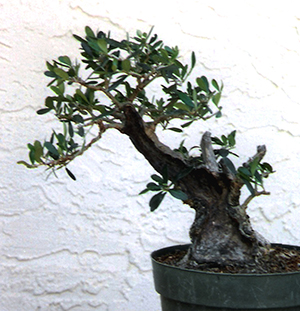
I was glad to get rid of the ugly green bark. One of the reasons to create olive bonsai is that they develop such a beautiful textured bark over time. The back of the tree already showed good signs.
Olives do best is rich, deep soil, so when I potted this tree in a bonsai pot, I put it in an extra deep pot. They will also grow in shallow, alkaline, or stony soil and with little fertilizer.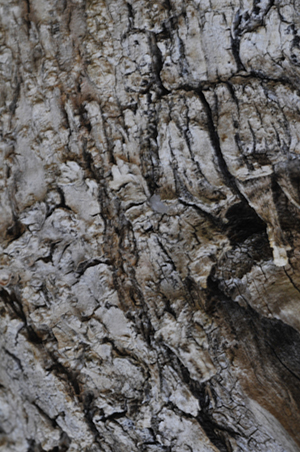
Olives like hot dry summers but can take temperatures down to 15o. Trunks and branches tend to grow stiff and straight, so pruning and training should begin early. Olea europaea leaves will come down to ½ or 1/3 size when potted as bonsai although Ollies may not come down quite so much.
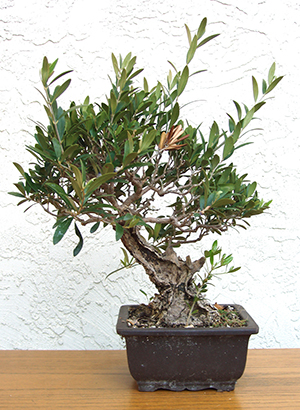
Now you know the truth. My bonsai are not always show-ready. The dirty pot, the dead leaves, and the four long leaders do not interfere with the health of the tree, as you can tell by looking at the dark green color of the leaves.
I grow Ollie in full sun, even in a bonsai pot, but don’t allow the roots to become completely dry. Ollies will grow in partial shade; but watering must be adjusted. My Ollie is planted in a loose mix, so I water it regularly. Over watering does not seem to harm it, nor did it die suddenly if it become over-dry.
When I started bonsai, the old-timers said having bonsai was like having children. You couldn’t go off and leave them to take care of themselves. They’re like children in other ways, too. With good care and training, they may grow up to be very nice. And sometimes not so nice. While I killed a few trees in the learning process, I didn’t have any children to spare, so if a child had a problem, I took him to see a doctor.
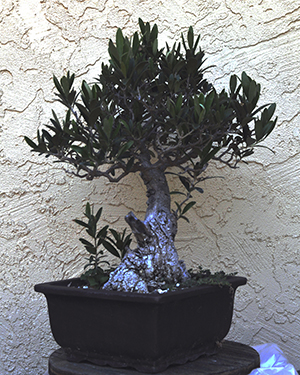
Here’s Little Ollie as an adolescent in 2008. A bit scruffy, needing a haircut, but showing some promise. Over time, I learned to use balanced fertilizer, as excess nitrogen causes excess growth and long internodes. I fertilize most of the year, as olives are evergreen and will grow during the San Diego winter. Late fall and winter call for 0-10-10.
When it comes to hair-cutting, olives can be grown almost exclusively by the clip-and-grow method, especially if this method is started when the plant is young. Leaves grow in pairs on either side of the branchlets, forming a trident. Cut the middle of the trident (slightly long; it will die back) let the two side branches develop from the axils of the leaves, and then select one branch to remove. Olives can be cut right up to the margin of a growing branch without causing the branch to die back; remove the undesirable branch, clean the cut, and seal.
Olives heal slowly; old wounds on trunks and branches may die back and rot in the center, creating an interesting blemish. On healthy trees, the cambium will re-grow and roll over somewhat, especially if a branch is left next to the wound to stimulate the flow of sap. Cuts should be concave, as the cambium is thick and will create a raised knot if the cut is not made concave. Sealing with glue or wound sealant seems to help keep the sap from withdrawing from the fresh-cut area.
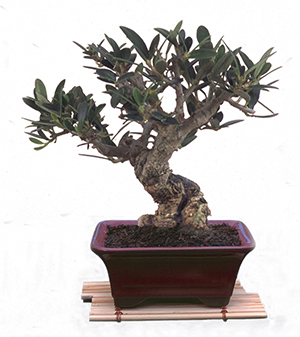
Roots can be severely pruned, left unsealed, and will not rot but will eventually callous over. After severe root pruning, the olive may sit a while recovering before throwing new top growth.
There are a number of ways to propagate olives, including cuttings. Cuttings, carefully managed, can be turned into Shohin bonsai. Here’s an example, four inches tall:

I was in poor health for a while, and my backyard children suffered. My wife watered during this period, but all other bonsai duties were beyond her. The next photo shows Ollie looking very scruffy, having suffered from lack of care and a social disease (whiteflies, hosted by hibiscus that float through the neighborhood in the wind.) When I finally could, I sprayed the underside of the leaves with a Neem oil solution, washed them with a strong spray of water, and removed any remaining whiteflies by rubbing them off with my thumb.
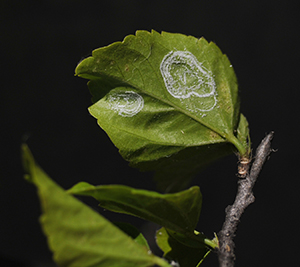
Don’t know what a whitefly is? They hide and lay eggs on the underside of leaves and over time, can weaken a tree so badly it dies.
Joe Grande, BCI Editor, has to deal with sudden temperature drops that may freeze or partially kill some of his plants. I deal with sudden temperature increases, in the form of hot Santa Ana winds that blow in from the Arizona desert. The brown leaves on Ollie were burned when an unexpected Santa Ana blew into San Diego in early April.
Clearly, Ollie needed to be transplanted and trimmed. Olives are hot weather, Mediterranean plants and are best transplanted in hot weather (May, June and early July). Like most plants, olives also can be transplanted when new growth begins.
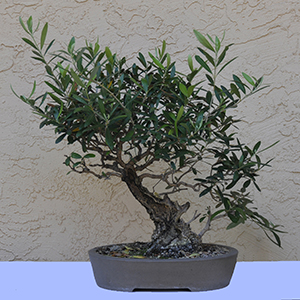
The final photo is of Little Ollie freshly transplanted and watered in.
